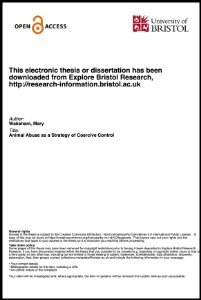By Michele Burman | Ruth Friskney | Jane Mair | Richard Whitecross
This Report presents the findings of the Domestic Abuse and Child Contact: The Interface Between Criminal and Civil Proceedings research project, funded by the Scottish Government. The study set out to examine the relationship between civil and criminal law in the context of child contact proceedings which raise issues of domestic abuse. The impetus behind the study is to better understand how, if at all, developments in domestic abuse proceedings and changing definitions in the context of criminal law in Scotland, inform the handling of child contact cases which are conducted within the scope of civil justice. Scotland has seen several major policy and legislative developments aimed at reforming responses to domestic abuse, most recently the introduction of the Domestic Abuse (Scotland) Act 2018. These developments have been primarily situated within the context of criminal law and the criminal justice process. There has been relatively less attention paid to civil law. The negative impact of domestic abuse on children is well-recognised in Scotland (see, e.g., Callaghan et al 2018). Growing awareness of the nature and impact of domestic abuse is reflected to some extent in the explicit statutory obligations, introduced by the Family Law (Scotland) Act 2006, on the civil courts to consider domestic abuse in the context of actions for child contact. In further recent debate and reform of child law and family justice, domestic abuse has been highlighted and children placed at the heart of the decision-making process. Decisions in respect of child contact generally, and in particular where there are allegations of domestic abuse, continue to present significant challenges. Relatively little is known of how these provisions of Scots family law work in practice; of the extent to which the treatment of domestic abuse in the civil courts reflects criminal practice, or of the ways in which individual child contact cases may (or may not) interact with criminal justice proceedings. How child contact, more generally, works in practice in Scotland, is an under-researched area with Wilson and Laing’s (2010) study a rare exception. The significance of the interaction of the criminal and the civil, in the context of domestic abuse and child contact, was clearly identified by the Scottish Government in the commissioning of a significant scoping project: Contact Applications Involving Allegations of Domestic Abuse: Feasibility Study (McGuckin & McGuckin 2004) but the planned Phase 2 did not follow. Much of the research evidence we have on this specific issue in Scots family law derives from two doctoral theses (Mackay 2012; Morrison 2014). Overall, there is limited research evidence on the operation of family law in child contact cases, and whether and how the interpretation and application of the civil law statutory provisions are informed by contemporary understandings of domestic abuse and changing definitions or practices in the criminal law. The research which has been published has consistently stressed the need for further, large scale (e.g., McGuckin & McGuckin 2004; Wilson & Laing 2010) and longitudinal study (e.g., Mays & Christie 2001). Through a focus on the interrelationship between the investigation and prosecution of domestic abuse in criminal justice and parallel child contact proceedings advancing through civil justice processes, this research study contributes to addressing the current knowledge gap. The key stated aims of the study are: a. to understand the ways in which domestic abuse proceedings may inform the handling of and decision-making in child contact cases; b. to explore family law practitioner understandings of the impact and relevance of a course of conduct of domestic abuse and its implication in contact cases under s.11 7A – C of the Children (Scotland) Act 1995; c. to identify and explain perceived impediments or obstacles to communication and information exchange in such cases; and d. to examine the links or lack thereof between domestic abuse criminal proceedings and Child Welfare Hearings (contact).
Edinburgh: Scottish Civil Justice Hub, Scottish Centre for Crime & Justice Research, 2022. 78p.















